| 1 | Patagonian lancehead |
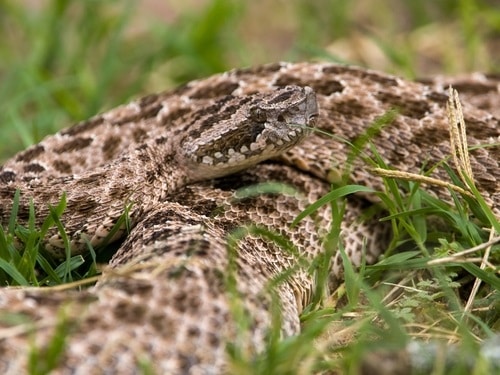
The official most southerly snake on Earth, among nearly 4000 species. Patagonian lanceheads reach a latitude of 47°, as well as high altitudes of over 3000 metres.
This species belongs to the 48 member Bothrops family, which includes the deadly fer-de-lance and jararaca. They’re the holder of many records, as they’re the only Bothrops pitviper to have an upturned snout, which gives them a “horn” like a rhinoceros. Their name B. ammodytoides originates from their similarity to the nose-horned viper of Greece (Vipera ammodytes). They also inhabit wild extremes of habitats, in forest, mountain and field, and temperatures ranging from 40C to -10C.
Patagonian lanceheads are short for their family, rarely reaching 100cm. Their venom is relatively potent for their size, and is strongly haemorrhagic and necrotic.
Patagonian lanceheads have no sexual dimorphism in colour, AKA variation between males and females. However, there’s variety within the species. Some B. ammodytoides are paler with a mostly clean beige belly. Others are a far darker grey, near black, and these have a heavily dotted belly. Patagonian lanceheads are endemic to Argentina, appearing in no other country.
| 2 | Arrow ground snake |
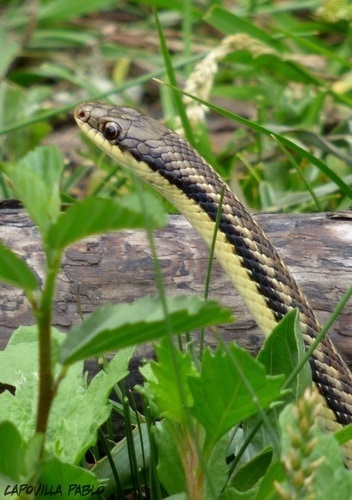
This species inhabits a swathe of Argentina, especially the west, and crosses into Paraguay and Bolivia to the north. Arrow ground snakes (Erythrolamprus sagittifer) live in dry Chaco regions, with mixtures of bushland and forests, and never rainforests. They have an especially creamy belly, but more variable patterns on their back. Some are brown with a black stripe on each flank, while others have large black circles. The creamy belly always remains.
Arrow ground snakes have especially bulging eyes from a bird’s eye view. While they may have a mild venom, they’re no threat to mankind. They fall victim to birds such as white-tailed hawks, and themselves feed mainly on reptiles and amphibians.
Death feigning is the speciality of this snake. When scientists found one in an open Chaco forest in 2014, it went slowly floppy in their hands. When they deposited the arrow snake on the ground, it contorted its body into unnatural shapes and went completely limp, not releasing its corpse-like deception even when poked and prodded. After a few minutes, the snake reactivated again, and slithered off, sensing that the danger had passed. Arrow ground snakes can also spread a small cobra-like hood when threatened.
| 3 | False tomodon snake |
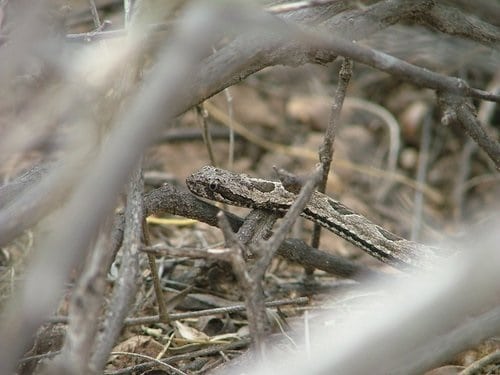
A small, humble snake which belongs to the obscure Tachymenis genus, which contains just 3 members. False tomodon snakes (Tachymenis trigonatus) are typically 45cm and a reach a confirmed maximum of 55cm. This is another snake which is endemic to Argentina, as it’s the southernmost of the 3 members. Tachymenis trigonatus has a distinctive pattern of small alternating triangles down its spine. It colours are beige-grey overall, similar to a viper, rather than juicy jungle green.
The Tachymenis family is mildly venomous, and its cousin, the Peruvian slender snake, has caused one confirmed fatality. None are on the record for Tachymenis trigonatus.
False tomodon snakes lay live young rather than eggs. Little is know about this species’ lifestyle, venom or diet, but we do know that it’s in the top 5 most southerly snakes worldwide. In fact, it may be the second most southerly, and therefore most southerly non-viper. This 2023 report mentioned how it was found on Isla Valdez, a small Atlantic island off the Argentinian coast. This observation extended its known range 100km to the south. But the legions of iNaturalist users have gone one better; this map shows it even further south. Tachymenis trigonatus is actually the southernmost snake on the giant iNaturalist map of all snake observations, though it doesn’t reach the southernmost confirmed observations of Patagonian lanceheads by scientists. In all likelihood, the false tomodon snake ranks third or second, unless there’s a shy underground blind snake that nobody has noticed.
| 4 | Tricolour hognose snake |
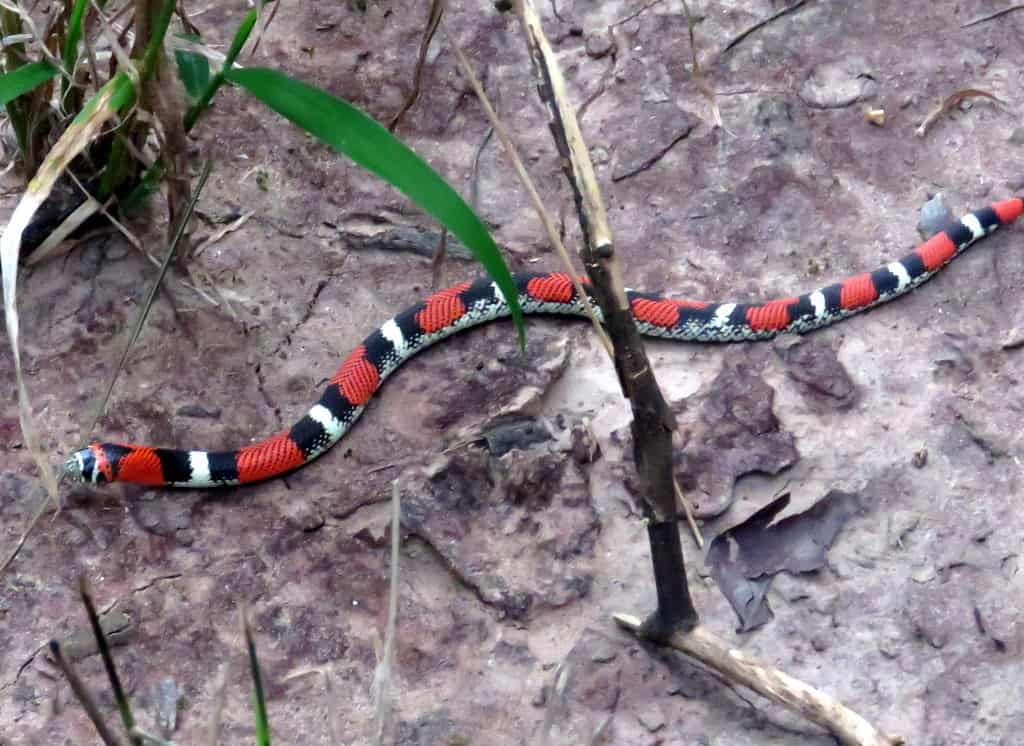
A coral snake mimic, which has similarly colours to the Argentinian coral snake it overlaps with. The two share an extremely similar range: a swathe of northern Argentina, plus Paraguay and Bolivia. Tricolour coral snakes have their own venom, but no deaths are known. Reptile keepers have reported little more than swelling or pain from bites.
Tricolor coral snakes average at 60-75cm. Instead of forests, they prefer open areas with sandy soils like grassland and savannahs, occasionally sparse woodland. This aids in their digging tendencies, for which their signature hognose is designed. Xenodon tricolor is like a faraway parallel of the USA’s western hognose snake. They have the upturned snout, liking for sand, and the same defensive tendency to flatten their upper body to appear larger.
Xenodon pulcher can be an extremely fast, caffeinated snake when agitated, jerking from side to side rapidly. The easy difference to Argentinian coral snakes is that Xenodon pulcher has red spaces, followed by black-white-black. The venomous snake it mimics goes black-white-black-white-black; there’s an extra band of each. Tricolour hognose snakes only reach central Argentina rather than the southern realms, lacking the cold-resistance of a Patagonian lancehead.
| 5 | Painted lancehead |
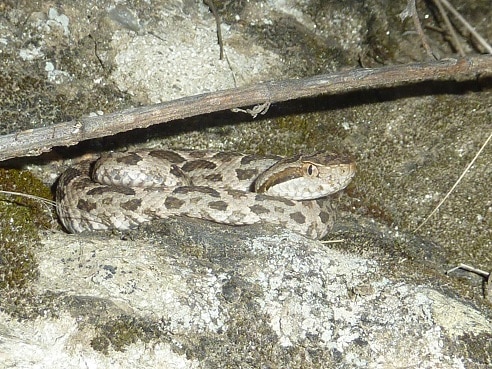
The venomous snake in Argentina responsible for the most bites, most hospitalisations and most deaths. Like the Patagonian lancehead further south, painted lanceheads (Bothrops diporus) belong to the 48-member Bothrops family, but are much more likely to inhabit farmlands, villages, roadsides, parks and areas of Argentina close to humanity, instead of high altitude areas. Painted lanceheads cover virtually the entire upper half of Argentina, and are common within that realm.
Painted lanceheads are weaker for swelling than other Bothrops pitvipers. But they’re especially strong for haemorrhaging, defeating the jararacussu, jararaca and crossed pitviper in a 1998 study.
Generally, painted lanceheads gravitate towards drier areas, like grassland, savannah and deciduous woodland. They’re the number one Argentinian snake a tourist or dog walker must be wary of stepping on. The maximum length is 110cm, and their beige-brown tones make for superb camouflage. Their diet is varied, consisting of 25-50% mammals, depending on location. There’s also Cururu toads, many-fingered teiids, and fellow snakes such as Tucuman threadsnakes and central sipos. Death is relatively rare, but usually caused by kidney failure. Luckily, the threat is so grave that Argentina manufactures its own antivenom against this species, which has a high effectiveness.
| 6 | Mousehole snake |
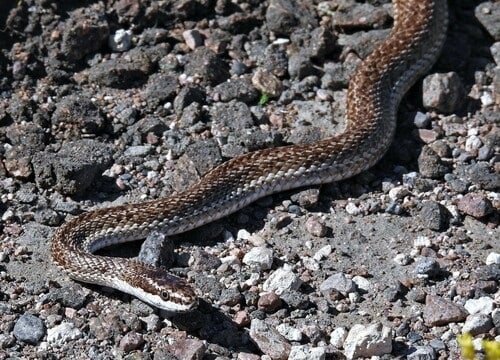
A fast-moving brown snake, usually with thin parallel stripes running down the length of its body. This species is never bright and flashy – if it’s green or orange, you’re staring at a different snake. Mousehole snakes almost completely inhabit Argentina, with scattered records in Bolivia to the north. They’re a southerly snake, but less southerly than the Patagonian lancehead or false tomodon snake.
Mousehole snakes regularly reach 160cm, and prey on mammals such the southern mountain cavy. They also snatch the fledglings of birds such as straight-billed earthcreepers. This is a egg-laying species, with one captive snake producing 16.
Mousehole snakes have brown eyes with round pupils. This is an adventurous snake, not lazy. Activities include crossing roads with no regard for cars, climbing up garden doors, and effortlessly climbing trees. Despite regularly falling victim to car tyres, they’re widespread enough that IUCN lists them as “least concern”. One of the original museum specimens was destroyed in the final days of World War 2, sometime from March 31st to April 5th 1945.
| 7 | Brown mussurana |
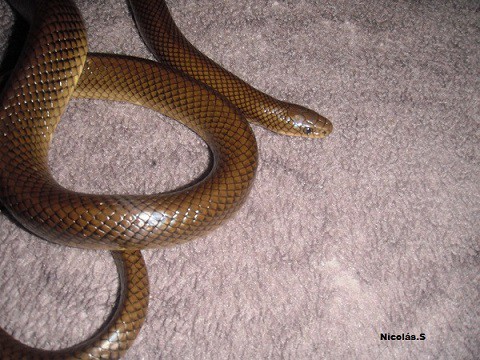
This constricting species is widespread, but most common in eastern Argentina, particularly the outskirts of Buenos Aires. Brown mussuranas are non-venomous, and eat a mixture of mammals, lizads and fellow snakes. They average at 90cm, with a maximum of 134cm, and the maximum altitude recorded was 1100 metres.
Recognisable features include black dots of eyes like a cartoon character, with round pupils, and a head with no separation from the neck. This is a very brown snake, with a slight black edge to each scale, creating an appearance like a dark net. All this contrasts against a pale, creamy belly. Originally, they were thought to belong to the Clelia genus, which contains the notorious snake-eating mussurana, a snake with total venom resistance. But in 2012, they were moved to their own genus: Paraphimophis, of which they’re the sole member.
The brown mussurana has a sneaky tactic for securing their offspring: laying their eggs in leafcutter ant nests. Younglings hatch with a similar appearance to adults, except for a slight pale neck collar. Brown mussuranas are also abundant in Uruguay to the northeast. Their habitats vary from damp grassland to wet forest.
| 8 | Gunther’s striped snake |
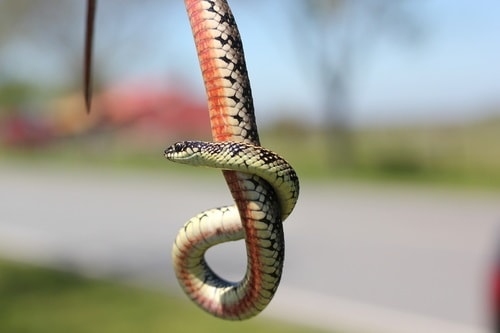
A common, harmless snake which measures 40-60cm and poses no threat to humanity. This snake inhabits similar regions to the brown mussurana: extremely abundant in eastern Argentina, including near Buenos Aires, and spilling into Uruguay. Gunther’s striped snakes roughly follow the course of the Paraná river and its many tributaries.
Gunther’s striped snake (Lygophis anomalus) has some of the most spectacularly detailed patterns of an Argentinian snake. They’re not neon bright, but richly detailed like an ornate rug. There’s a pair of fine white lines down their back, with red splashes of colour inbetween. Their belly is pale with more red splashes, and their eyes are reddish with a round pupil. A handful are far darker than the norm, but the two white lines always remain. The maximum length in males is 66cm, while females are longer at maximum of 75cm.
Gunther’s striped snakes overwhelmingly eat frogs and toads, keeping the occasional reptile as a backup. A study on 444 preserved museum specimens found prey such as two-coloured oval frogs, Bella Vista toads and Montevideo tree frogs. The latter is also confirmed prey for snakes such as Lichtenstein’s green racer.
| 9 | Golden liophis |
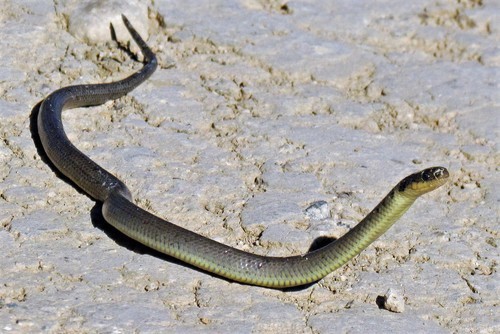
A snake of Uruguay, southern Paraguay, and a large swathe of northeast Argentina. This is a predominantly aquatic snake, which swims through tributaries and opens its mouth wide in order to catch small frogs and fish. The rivers it inhabits are so swarming with life that this simple strategy is bound to succeed eventually.
Male golden liophis are shorter than females, but have a longer tail. This is a docile and calm snake, which rarely exceeds 1 metre. They belong to the same Erythrolamprus family as the arrow ground snake earlier on this list, yet are far more aquatic overall. According to a 2015 study from eastern Argentina, nearly 60% of its diet was fish, the remainder being frogs and toads.
The golden liophis indulges in one of the most popular snake preys of South America: the marbled swamp eel (Synbranchus marmoratus). This is an inland eel which is found in rivers above large waterfalls, which reaches 150cm, and can even move on land if stranded in small forest pools when waters recede. Other species known to prey on marbled swamp eels include Brazilian smooth snakes, aquatic coral snakes, Allen’s coral snakes, American pipe snakes and many more. Something about them just tastes amazing for snakes.
| 10 | Argentinian coral snake |

The Argentinian coral snake is a common member of the huge, 82-strong coral snake family, most of which are dangerously neurotoxic. It inhabits a large territory, including Paraguay, Bolivia and southern Brazil, but Argentina is its heartland. This is a medium-sized species, at a maximum of 125cm.
Micrurus pyrrhocryptus typically lives at low elevations of 100-500 metres above sea level. Compared to many coral snakes, which are rainforest lovers, it prefers drier habitats, such as deciduous tropical forests, grassland, shrubland and savannah.
Like most coral snakes, Micrurus pyrrhocryptus feeds on snakes, and apparently they aren’t fussy. A captive male was successfully fed Bolivian snail eaters, a banded hognose snake Guibe’s flame snake and banded cat-eyed snake over 8 months. Proven wild prey include La Villa’s slug-eating snakes and Brongersma’s worm snakes.
A 2001 study found that its venom was clearly specialised against snakes, achieving the highest LD50 toxicity score. It was also tested against a white mouse, two fish, and a legless lizard (amphisbanean), where the venom was still deadly, yet weaker. The venom was weakest in the two fish. Argentinian coral snakes also have a proven nemesis of their own: the laughing falcon.
